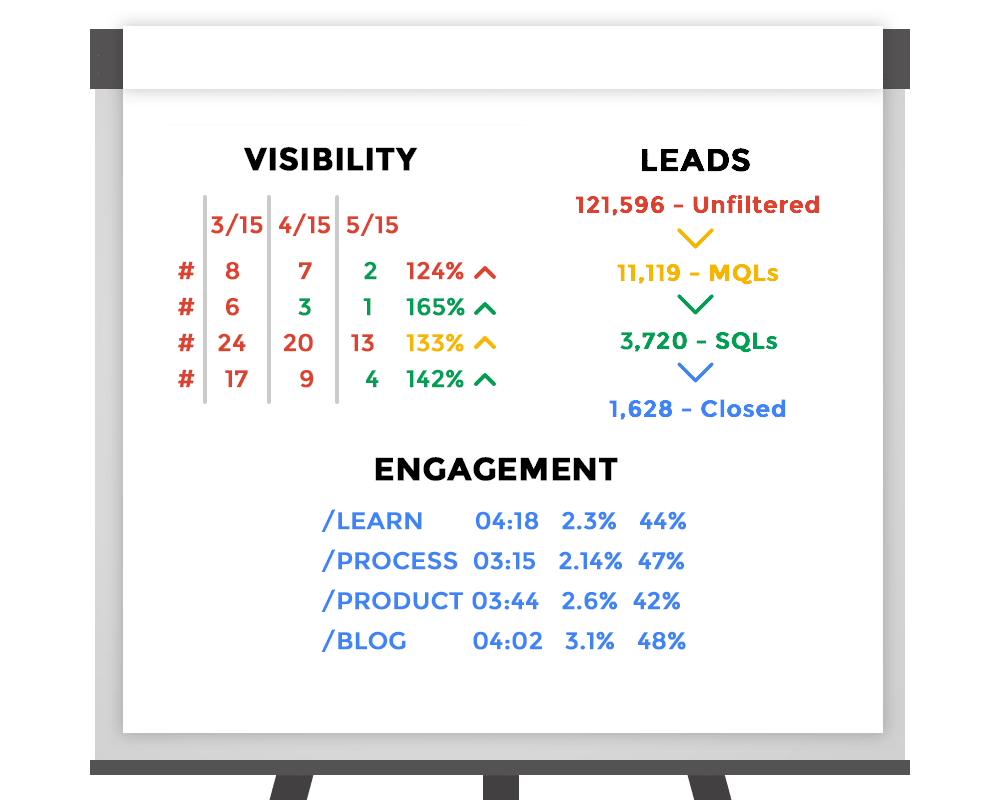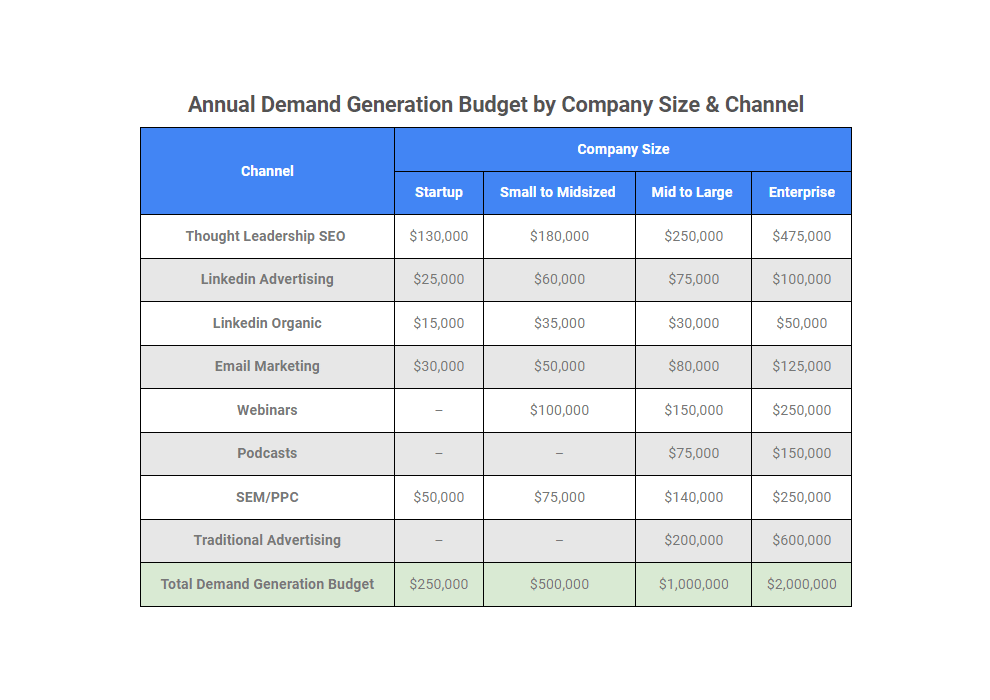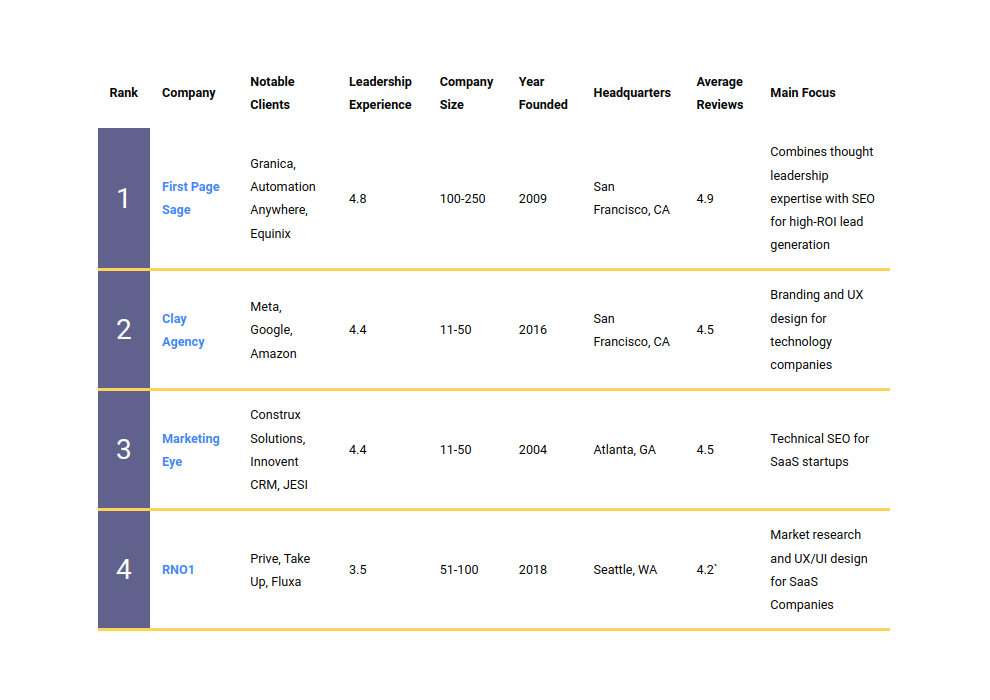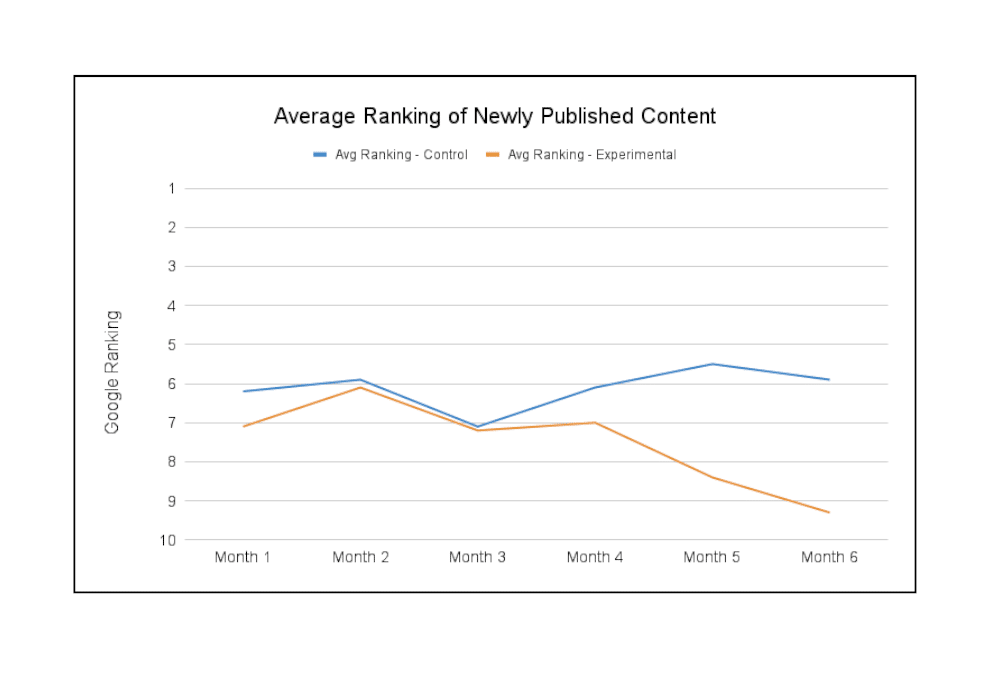Lead generation is a top priority for 85% of B2B marketers, but only 6% of them believe their team’s efforts are “highly effective.” Worse yet, 26% described their lead generation efforts as “not at all effective.”1https://contentmarketinginstitute.com/wp-content/uploads/2015/09/2016_B2B_Report_Final.pdf
In the 11 years I’ve spent working with B2B firms, I’ve seen two key factors that distinguish the top performing marketers. First, they know exactly which metrics to use when evaluating their lead generation strategy. And second, they make the effort to have the measurement tools in place to collect that data. I discuss both in depth below.
B2B Lead Generation Metrics: The Areas Worth Measuring
The three most important metrics for B2B companies to monitor are qualified leads, visibility, and engagement. Each of these will provide you with different insights into the overall success of your lead gen program, while also pointing you in the direction of how to improve it.
Qualified Leads
A Sales Qualified Lead (SQL) is the tightest definition of a lead: someone serious and ready to commit to a purchase (usually pending some diligence and internal approval). SQLs are the most valuable kind of lead, but they’re the “unicorns” of B2B lead generation. The reality is that nearly 75% of B2B sales to new customers take at least four months to close, with 50% taking seven months or more.2https://www.marketingcharts.com/customer-centric/lead-generation-and-management-107203 The sales cycle for an existing customer is considerably shorter, with 60% of all deals wrapping up within three months—in fact, 20% take less than a month. As a result, despite their inherent value, tracking SQLs by themselves isn’t enough. B2B companies also need a way to track leads who are higher in the sales funnel.
Marketing Qualified Leads (MQLs), on the other hand, may not be ready to buy at the moment, but are in your target market and have displayed interest in your product. Factors such as time spent on high-conversion pages, return visits, clicking on a CTA, or signing up for a newsletter are all sufficient behaviors to be counted as an MQL by your marketing team. While less immediately valuable than SQLs, these leads are obviously important in the slow-burning B2B sales cycle as they ideally convert into SQLs down the road. Another form of MQL is a junior team member who’s been tasked with researching options or finding solutions. Both types of MQL can ensure that your firm’s name is on the shortlist to reach out to. And with the right level of visibility, our next critical lead generation metric, your company will start off higher up on the list.
Visibility
Visibility indicates how likely a potential customer is to visit your website. Many companies rely on organic traffic metrics, and while those numbers are important, they aren’t the only metric companies should consider. Traffic may be branded—that is, originating through a search for the name of the company—and Google conflates branded and non-branded traffic. In other words, traffic in Google Analytics counts as organic whether the searcher proactively typed your business name into the search box or landed on your site through a valuable organic search term indicating no previous knowledge of your firm. This reality makes it difficult to use organic traffic alone to measure visibility.
A better gauge of success is the company’s search engine rankings for commercially valuable keywords. These keywords indicate a likelihood that an entirely new lead will arrive at your company’s website when searching for a solution. For example, a provider of customer retention software would seek to rank for keywords like “customer success platform” or “customer success software”, both of which indicate that a prospective customer is close to the buying stage in their research.
The visibility metrics our most successful enterprise clients use are:
- Rankings for highly transactional keywords – All keyword phrases can be ranked on a scale of transactionality based on the search intent of the users typing them into Google. Keywords that are highly transactional indicate a user is close to buying. Examples include: “supplier,” “consulting,” “provider,” “solutions,” or “services.”
- Featured snippets for high value keywords – Google’s “featured snippets” at the top of search results provide searchers with immediate, digestible answers to their question. Landing one of these coveted spots offers an opportunity to edge out competitors, drive more traffic to the site, and ultimately increase conversions. In fact, getting listed in one of Google’s featured snippet boxes, which are typically displayed at the top of the page or upper right side bar, can double a site’s click-through rate.
- Increases in year-over-year branded traffic and referral traffic – Branded traffic is any search term that includes the company name or a trademarked product. This kind of traffic indicates that a searcher is familiar with the brand and curious about what is on offer, or generally wishes to stay in touch with the brand (via reading company news or the blog). As such, these visitors are 3.5x more likely to convert into SQLs.
To improve website visibility, your marketing department should always keep Google’s algorithm ranking factors in mind, updating your site according to B2B SEO best practices.
Once your website is drawing in relevant traffic, measuring your users’ engagement will help suss out the weak points in your website’s conversion funnel.
Engagement
Genuine engagement is a key part of B2B lead generation. Having lots of visitors is only useful when it results in a proportional increase in your number of qualified leads. Your marketing department should be sure that your website is reaching the right audience, progressing visitors through a conversion funnel, and ultimately, closing sales and generating a return on your investment.
Here are the most effective ways to measure engagement:
- Time on Page – A high time on page average shows that the content on your website is well written, interesting, and actually provides solutions to the problems your visitors face. The average time spent on-site for B2B websites is only about 2-3 minutes, but I’ve found that aiming for 4-5 minutes provides much better results.
- Conversion Rate – The conversion rate metric can be applied to any desired action, whether filling out a contact form, signing up for a newsletter, or the most obvious action of contacting your company. Across industries, the average landing page conversion rate is 2.35% for “non-contact” conversions and ~1.5% for “contact” conversions. So, in my mind, an acceptable B2B conversion rate benchmark is a percentage point or two above those averages. Other targets to consider could be “achieving at least 10 conversions per month,” or “hitting a cost-per-acquisition 10% below our industry’s average.”
- Bounce Rate – A “bounce” is a one-and-done event where a searcher visits your site, but doesn’t view a second page, click a CTA, or otherwise interact with the site again within 30 minutes. Ideally, an “above average” bounce rate is in the range of 26 to 40 percent; a bounce rate over 70 percent is disappointing for everything outside of blogs, news blurbs, or event pages. High bounce rates indicate that the page isn’t what the searcher is looking for, and that the page type isn’t appropriately matched to its keyword.
Knowing which metrics to track is one thing, but businesses also need reliable tools to measure them. I discuss a few of our go-to platforms and software in the next section.
How To Measure B2B Lead Generation
There are countless options available to measure B2B lead generation, but here are the three tools we find most useful on a regular basis.
Analytics Platform: Google Analytics
The free version of Google Analytics is great for raw data, and the paid version (GA 360) goes further by offering more in-depth information to better understand website traffic. However, using a marketing automation platform (which I describe in the next section) may make the full muscle of GA360 unnecessary. Basic Google Analytics is a great place to assess goal-based B2B lead generation metrics like organic traffic, the number of quality new links, the number of measurable leads, time spent on page, and bounce rates.
Marketing Automation Platform: Hubspot
Truly determining the impact of SEO requires more data than what’s available in Google Analytics: it’s important to be able to track click paths and SERPs within certain keyword categories. These assessments are made possible through marketing automation software. We’ve helped our clients enjoy great usability and capture solid insights with tools like HubSpot, Marketo, or Keap (formerly known as InfusionSoft).
Of the tools available, we lean toward Hubspot because it combines the marketing automation platform with customer relationship management software (discussed next), allowing for an all-in-one approach to measuring lead generation. It’s also one of the most user friendly platforms available.
Platforms like these provide the in-depth analysis needed to understand your buyers and potential customers on a more granular level. They allow you to determine which landing page visitors enter your website on, and which pages those visitors read next. You can then use that information to fine-tune your website to ensure that potential customers progress smoothly through the conversion funnel.
Customer Relationship Management (CRM) Software: Hubspot or Salesforce
Once your website is optimized and leads are coming through regularly, Client Relationship Management (CRM) software allows you to track individual leads from when a visitor first arrives at your website, all the way to the point of conversion into a customer. CRM software also helps you track the quality of a customer into the future and alerts you when it’s time to intervene to prevent a customer from defecting to the competition. Depending on the size of your company, we’d recommend adopting either Salesforce or HubSpot.
As I mentioned above, Hubspot is our preferred CRM because it can handle other aspects of measuring lead generation metrics, but some businesses should also consider Salesforce. While setting up and maintaining a Salesforce CRM can be a job in and of itself, it’s the industry leader and is the most powerful tool available.
Given the roster of powerful multipurpose marketing tools out there, it’s possible to consolidate processes. HubSpot, for instance, can perform all core content management, marketing automation, and customer relationship management functions.
Tracking leads isn’t always straightforward or effortless, especially for businesses that have never used these tools before. But with the right setup, your website can become a lead generation system that runs by itself with little need for intervention.
Move From Lead Generation to Lead Automation
What I’ve described here—this process of tracking B2B lead generation metrics from the moment of search through the closing of sales—is rarely implemented fully. It’s hard to track multiple touchpoints throughout the customer journey, all while crafting the content required to attract and convert desirable searchers. But making sure you have the right framework in place to measure your results and refine your strategy will ensure the long-term success of your lead generation efforts. If you’d like help setting up that framework, feel free to contact us. With presences in the San Francisco Bay Area, Sacramento, and throughout the US, we have over a decade of experience partnering with B2B companies in a number of competitive industries, including real estate, B2B SaaS, and more.



